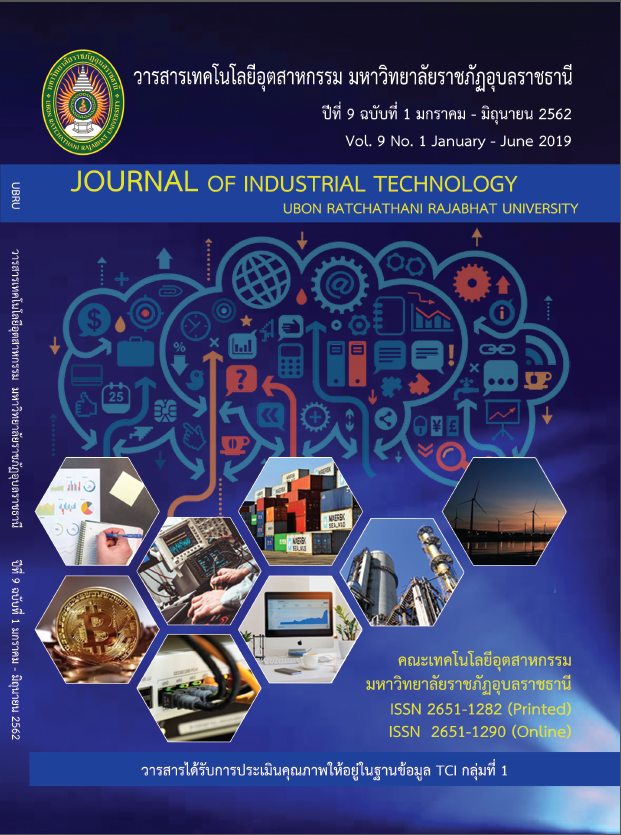การประยุกต์ใช้เทคนิคแบบรวมเพื่อเพิ่มประสิทธิภาพแบบจำลองตามกฎ ในเหมืองข้อมูล
Main Article Content
บทคัดย่อ
การสร้างแบบจำลองเพื่อการพยากรณ์ตามกฎให้มีประสิทธิภาพสูงเป็นงานวิจัยที่ท้าทาย งานวิจัยนี้จึงมีวัตถุประสงค์เพื่อเพิ่มประสิทธิภาพของแบบจำลองพื้นฐานรวมถึง ฟูเรีย โมเด็ม และริปเปอร์ ด้วยเทคนิคแบบรวมที่เป็นที่นิยมรวมถึงเทคนิคแบคกิ้งและเวทอินสแตนด์แฮนด์เวฟเปอร์ โดยใช้ข้อมูลผู้ป่วยโรคมะเร็งเต้านม จำนวน 699 คน และข้อมูลผู้ป่วยโรคเบาหวาน จำนวน 768 คน การวัดประสิทธิภาพแบบจำลองได้ทดลอง แบ่งชุดข้อมูลออกเป็นชุดข้อมูลเรียนรู้ และชุดข้อมูลทดสอบข้อมูลด้วยการใช้หลักการ 10 โฟวร์ ครอส ฟาลวาเดชั่น และทำการทดลอง 10 รอบ เพื่อลดความลำเอียงของการทดลอง ในการวัดประสิทธิภาพการพยากรณ์ของแบบจำลองที่สร้างจากแต่ละเทคนิคด้วยค่าความไว ความเฉพาะ และความถูกต้อง จากการศึกษาพบว่า เทคนิคแบคกิ้งสามารถเพิ่มค่าความถูกต้องในการพยากรณ์การเกิดโรคมะเร็งเต้านมได้สูงถึง 4.91%
Article Details

This work is licensed under a Creative Commons Attribution-NonCommercial-NoDerivatives 4.0 International License.
บทความที่ได้รับการตีพิมพ์ในวารสารฯ ท้ังในรูปแบบของรูปเล่มและอิเล็กทรอนิกส์เป็นลิขสิทธิ์ของวารสารฯ
References
[2] Hühn J. and Hüllermeier E. Furia: An algorithm for unordered fuzzy rule induction. Data Miningand Knowledge Discovery. 2007; 19(3): 293–319.
[3] Stefanowski J. The rough set based rule induction technique for classification problems.
In Proceedings of 6th European Conference on Intelligent Techniques and Soft Computing EUFIT. 1998; 98: 109-113.
[4] Cohen W W. Fast effective rule induction. In Machine Learning Proceedings 1995. 1995: 115-123.
[5] Wichareung S. Applying Data Mining Technique in Loan Approval Process. Bangkok: Dhurakij Pundit University; 2010.
[6] Lotte F, Lécuyer A and Arnaldi B. Furia: An Inverse Solution Based Feature Extraction Algorithm Using Fuzzy Set Theory for Brain –computer interfaces.. IEEE Transactions on Signal Processing. 2009; 57(8): 3253-3263.
[7] Gil-Herrera E et all. Rough Set Theory Based Prognostic Classification Models for Hospice Referral. BMC Medical Informaitics and Decision Making. 2015; 15(1): 98.
[8] Thakur S, Meenakshi, E. and Priya, A, "Detection of malicious URLs in big data using RIPPER algorithm," in 2017 2nd IEEE International Conference on Recent Trends in Electronics, Information & Communication Technology, 2017, pp. 1296-1301.
[9] Belhadj S A, Benmoussat N and Della K M. A Bagging Svms to Learn from Event Related Potentials Using Electroencephalography. 2017 5th International Conference on Electrical Engineering - Boumerdes (ICEE-B). 2017: 1-7.
[10] Riana D and Hidayanto A N. Integration of Bagging and Greedy Forward Selection on Image Pap Smear Classification Using Naïve Bayes. 2017 5th International Conference on Cyber and IT Service Management (CITSM). 2017: 1-7.
[11] Basterrech S and Mesa A. Bagging Technique Using Temporal Expansion Functions. In al. PKe, editor. Proceedings of the Fifth Internal Conference on Innovation in Bio-Inspired Computer and Application. 2014: 395-404.
[12] Michalski R S, Mozetic I, Hong J. and Lavrac N. The Multi-Purpose Incremental Learning System AQ15 and its Testing Application to Three Medical Domains. In Proceedings of the Fifth National Conference on Artificial Intelligence, Philadelphia, PA: Morgan Kaufmann. 1986: 1041-1045.
[13] Strack, B., et al. Impact of HbA1c Measurement on Hospital Readmission Rates: Analysis of 70,000 Clinical Database Patient Records, BioMed Research International. 2014: 11.

